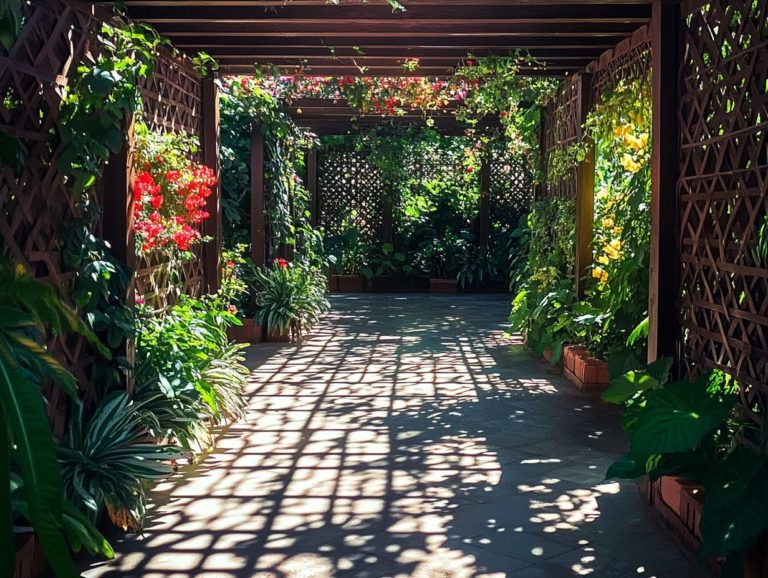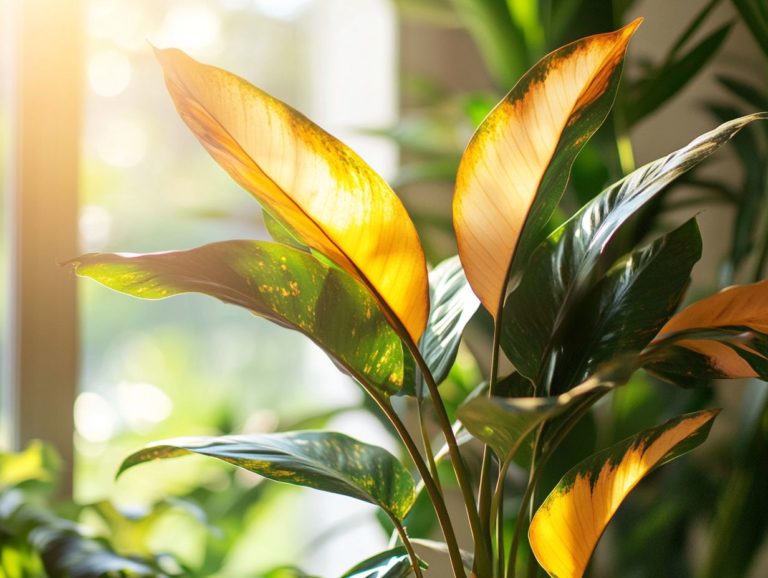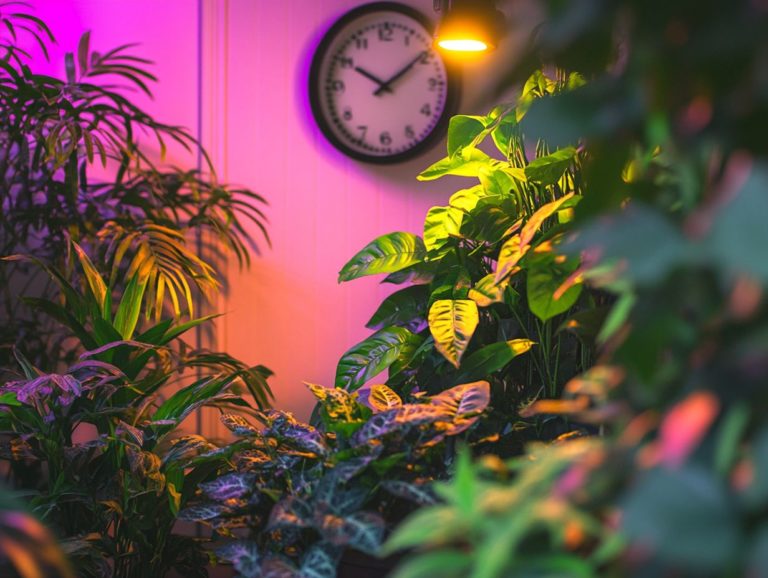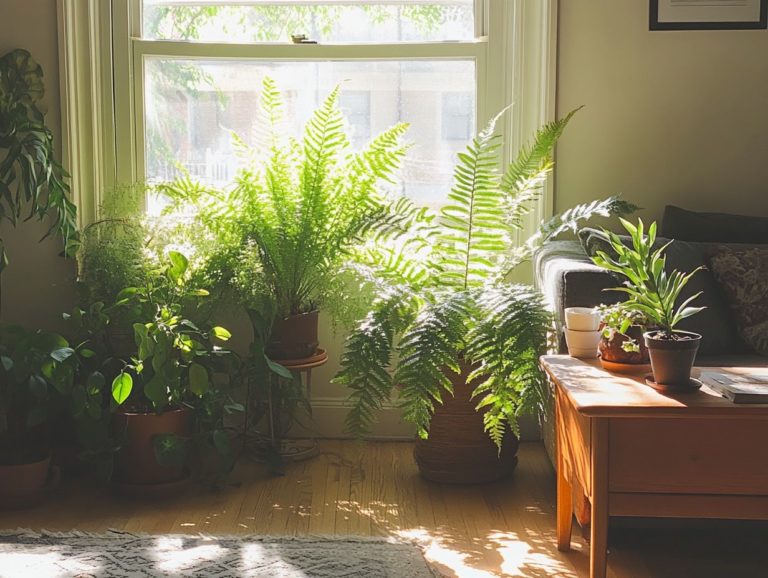The Impact of Light on Plant Health
Light transcends mere illumination; it is a vital cornerstone for the health of your plants.
Grasping how light impacts the process that allows plants to turn light into food, growth, and overall development is essential for anyone dedicated to cultivating thriving greenery. Let’s explore the various types of light both natural and artificial and how different wavelengths can affect your plants’ well-being.
You will gain the ability to recognize signs of light-related health issues and uncover strategies for optimizing light exposure, all while taking into account the other environmental factors that contribute to vibrant plant life.
Contents
- Key Takeaways:
- The Importance of Light for Plants
- Types of Light and Their Effects
- Signs of Light-related Plant Health Issues
- Optimizing Light for Plant Health
- Factors to Consider for Optimal Light Exposure
- Additional Factors Affecting Plant Health
- Other Environmental and Nutritional Factors
- Frequently Asked Questions
Key Takeaways:

- Light plays a crucial role in photosynthesis and plant growth and development. Without enough light, plants may struggle to survive and thrive.
- Natural and artificial light have different effects on plants, and understanding different wavelengths is important for optimizing plant health.
- Signs of light-related plant health issues include stunted growth, discolored leaves, and leggy stems. Optimizing light exposure and considering other environmental and nutritional factors can help improve plant health.
The Importance of Light for Plants
Light is crucial for your plants’ health and development. It profoundly impacts photosynthesis, which is the process that allows plants to turn light into food. This energy is fundamental for growth, flowering, and overall biomass production of plants like tomatoes and corn, as well as indoor flowering species such as Poinsettias and Kalanchoes.
The intensity, duration, and quality of light exposure you provide directly influence the chlorophyll levels in the leaves. This affects their color and size, ultimately determining how well your plants flourish. Understanding the science of light and plant care is crucial in both natural sunlight and artificial light settings like greenhouses or indoor grow rooms.
Role of Light in Photosynthesis
The significance of light in photosynthesis is paramount. It serves as the primary energy source that drives this crucial process in plants. It gives them the power to transform carbon dioxide and water into glucose and oxygen.
Delving into the mechanics of photosynthesis, you ll discover how chlorophyll the green pigment in plants masterfully absorbs specific wavelengths of light, particularly from the blue and red spectrum, to maximize energy capture. This selective absorption is essential, as it directly influences the efficiency of the entire photosynthetic process.
In any environment, whether you re in the great outdoors or in a meticulously controlled indoor setting, the availability of photosynthetically active radiation (PAR) plays a significant role in determining plant growth and productivity.
Different light spectra each contribute uniquely to photosynthesis. Varying wavelengths impact how effectively plants harness energy, thereby enhancing their ability to thrive and reproduce.
Effects of Light on Plant Growth and Development
Light intensity and duration play a pivotal role in your plants’ growth and development. They influence essential factors such as biomass accumulation, leaf size, and leaf color ultimately determining their overall health.
These effects become especially pronounced during critical growth stages. When light conditions vary, you may find your plants becoming spindly, characterized by elongated stems and dull leaf color, which can lead to disappointing yields. For example, insufficient light during the flowering phase can significantly hinder fruit production, resulting in lower-quality yields. Understanding the role of natural light in plant growth is essential for optimizing your indoor gardening efforts.
To tackle these challenges in indoor horticulture and greenhouse environments, you can adopt various strategies, such as:
- Utilizing full-spectrum LED grow lights that mimic natural sunlight.
- Employing reflective materials to optimize light distribution.
You can also adjust the duration of light exposure, typically managed through a meticulously monitored photoperiod, to enhance plant health across various growth stages. For more insights, consider understanding the impact of light quality, which fosters robust flowering and improved biomass production.
Types of Light and Their Effects
Understanding the various types of light and their impacts is essential for optimizing plant growth and health. Natural sunlight and artificial light sources, such as LEDs, play pivotal roles in both indoor and outdoor horticulture.
By mastering these elements, you can elevate your gardening efforts and ensure your plants thrive beautifully.
Natural vs. Artificial Light
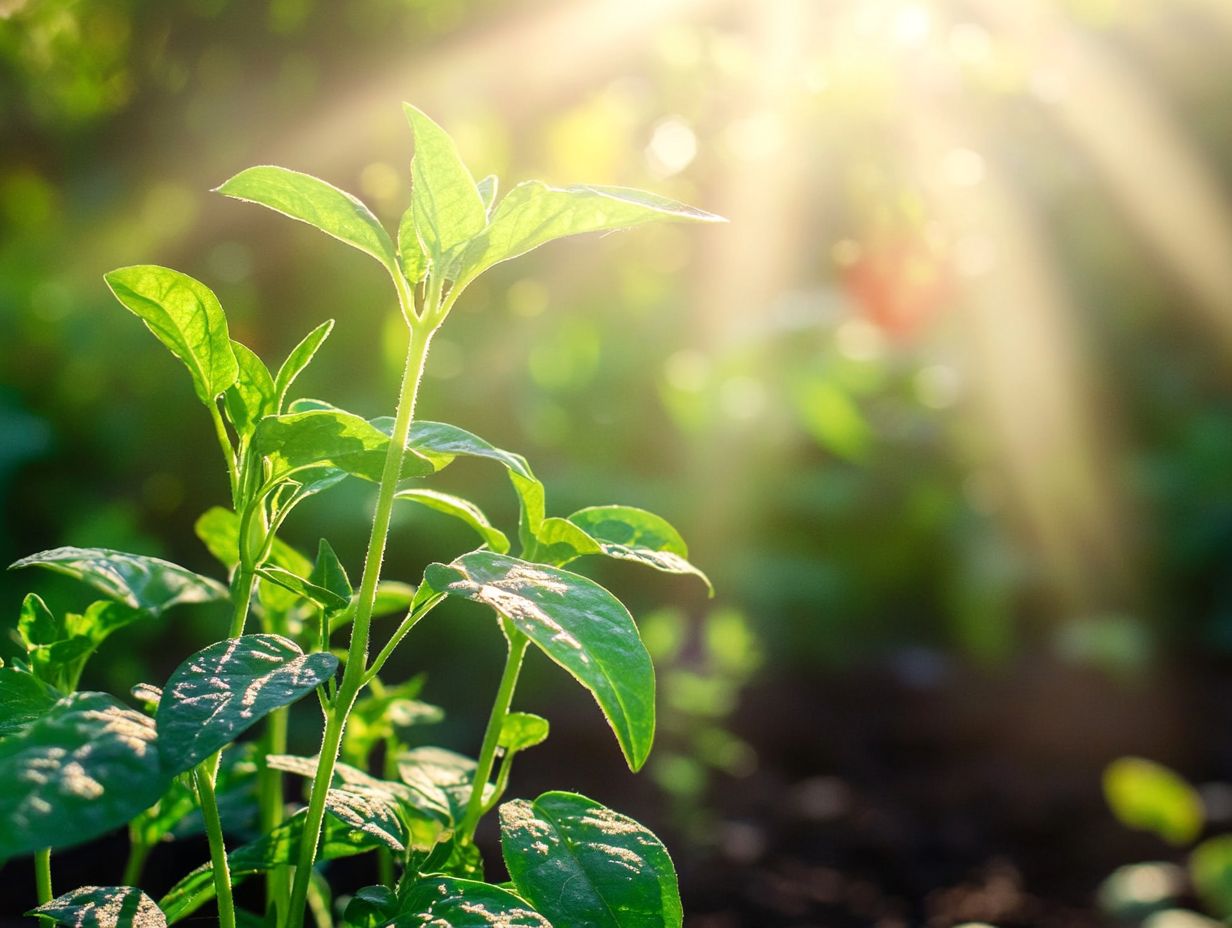
Natural light from the sun offers an unmatched spectrum of wavelengths that are essential for plant growth. In contrast, artificial light sources like LEDs provide tailored solutions for your indoor horticulture and greenhouse environments.
Both options have unique advantages and disadvantages when it comes to supporting photosynthesis and maintaining overall plant vitality.
Natural sunlight, with its extensive range of wavelengths, is critical for stimulating robust growth and flowering. However, it can be inconsistent due to varying weather conditions and seasonal shifts.
Conversely, artificial lighting allows for precise control and adjustments to meet specific plant needs. However, it may not completely replicate the dynamism of sunlight.
If you re cultivating plants indoors, supplementing with lighting during shorter days can significantly boost growth. This compensates for light deficits and optimizes plant health by extending the photosynthetic period.
Understanding Different Wavelengths
Different wavelengths of light especially red, blue, and far-red play unique roles in plant growth. They significantly influence chlorophyll production, flowering, and overall morphology.
Understanding how these wavelengths operate can elevate your cultivation strategies to new heights. For example, blue light is crucial for vegetative growth, promoting lush leaf development. Meanwhile, red light is essential for triggering the flowering stage. To delve deeper into how light impacts this process, check out the role of light in plant propagation.
The relationship between these wavelengths highlights the importance of light quality and the range of light wavelengths. These factors can impact plant health, yield, and quality across various environments.
As a grower, adjust your lighting systems based on specific growth stages to optimize results, ensuring that your plants receive the specialized light they need for peak productivity.
Spotting light-related plant health issues can make a huge difference in your gardening success. Symptoms like spindly growth, yellowing leaves, and poor flowering may indicate that your plants are suffering from insufficient or excessive light exposure.
By being attuned to these cues, you can ensure that your plants thrive in their optimal lighting conditions.
Common Symptoms and Causes
Common symptoms of light-related issues in your plants include yellowing leaves, stunted growth, and spindly structures. These often stem from improper light exposure or an inadequate light source.
These symptoms can appear in different ways, depending on whether your plants are basking in too much light or yearning for more.
For example, if your plants are overexposed to direct sunlight, they may develop scorched leaves. Conversely, those tucked away in shady corners might stretch desperately toward a light source.
Identifying these issues early is essential. By observing color changes and growth patterns, you can accurately pinpoint the problem.
Act quickly to remedy these symptoms. Implement solutions like adjusting the distance from light sources, utilizing grow lights, or rotating your plants to significantly enhance their health and vibrancy, especially by understanding light quality for plants.
Optimizing Light for Plant Health
When you optimize light for plant health, you’re tapping into the essential elements of light exposure, intensity, and duration. These factors should be tailored to the specific needs of different plant species.
This is particularly crucial in indoor horticulture settings, where creating the perfect lighting conditions can significantly enhance growth and vitality.
By mastering these factors, you ensure that each plant thrives in its environment.
Factors to Consider for Optimal Light Exposure
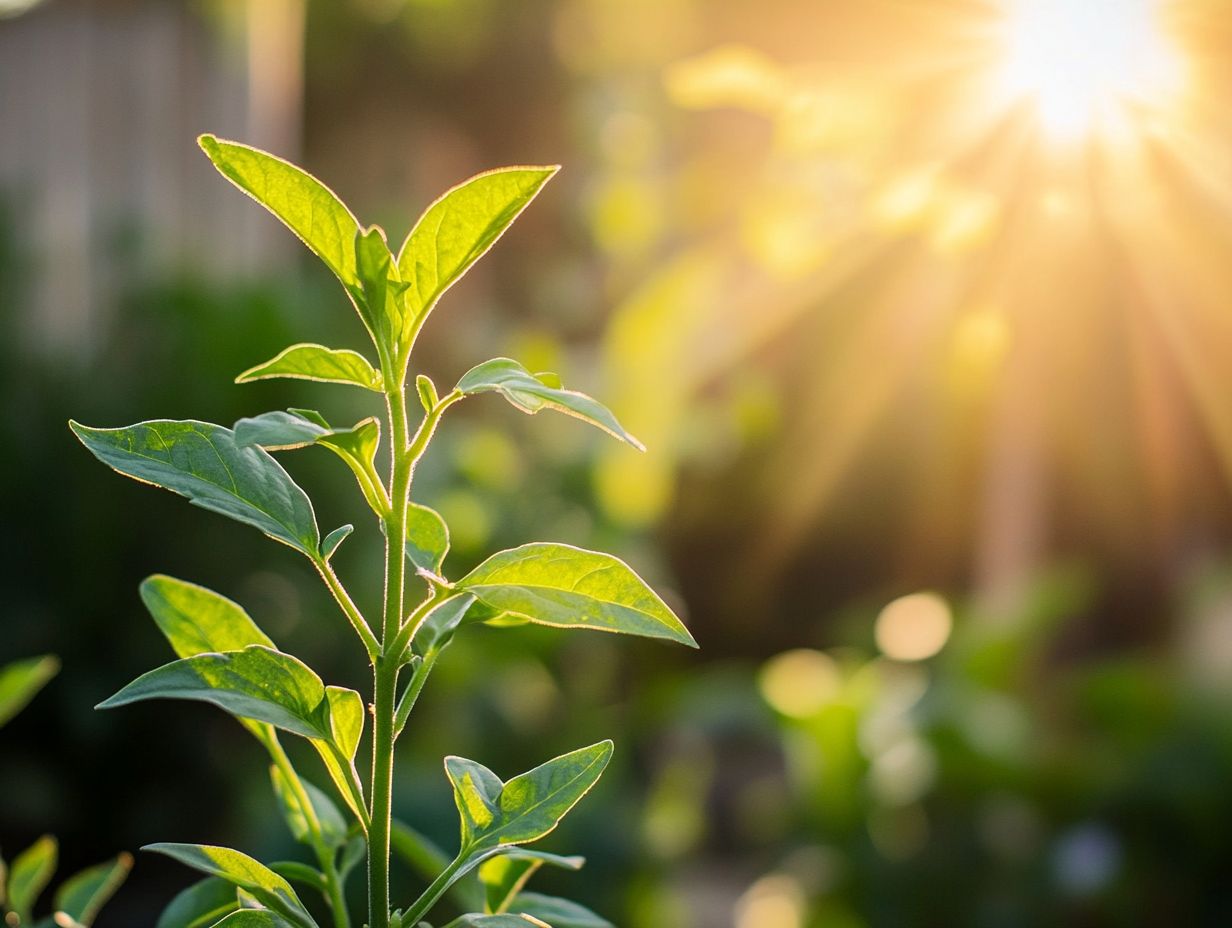
To achieve optimal light exposure, you must balance several factors. These include light intensity, humidity levels, and temperature.
Each of these elements is vital for enhancing the health and vitality of your indoor plants. The interplay between light and other environmental conditions is crucial. For instance, too much light can cause rapid water loss if you don’t keep humidity levels in check. Additionally, understanding the impact of water quality on plant health is essential, as insufficient warmth can slow down photosynthesis, even when light exposure is adequate.
To strike that perfect balance, monitor humidity with a hygrometer a tool to measure humidity. Aim for levels between 40-60% for most houseplants. Position your plants near windows that provide filtered sunlight to shield them from direct exposure that may lead to stress. Incorporating a fan helps maintain optimal airflow, ensuring a stable temperature around your greenery. Regularly checking and adjusting these factors will create a thriving environment for your plants to flourish!
Additional Factors Affecting Plant Health
Plus light, various environmental and nutritional factors profoundly influence plant health. Temperature, humidity, and the availability of essential nutrients all play crucial roles in fostering optimal growth and vitality.
Other Environmental and Nutritional Factors
Temperature and humidity levels are pivotal in shaping plant health and their capacity to harness light for growth. Temperature significantly impacts the rate of photosynthesis. Warmer conditions can boost enzymatic activity, enhancing essential metabolic processes for development. However, excessively high or low temperatures may introduce stress, ultimately hindering growth.
Humidity also plays a critical role in plant transpiration, influencing how water is absorbed and distributed throughout the plant. Maintaining optimal humidity levels enhances nutrient uptake, as water is the vehicle for essential minerals moving from the soil to the plant.
The interplay between temperature, humidity, and light establishes a harmonious environment for robust plant development.
Frequently Asked Questions
What is the impact of light on plant health?
Light plays a crucial role in plant growth and overall health. It is essential for photosynthesis, which is the process by which plants convert light energy into chemical energy to produce food.
How does light affect plant growth?
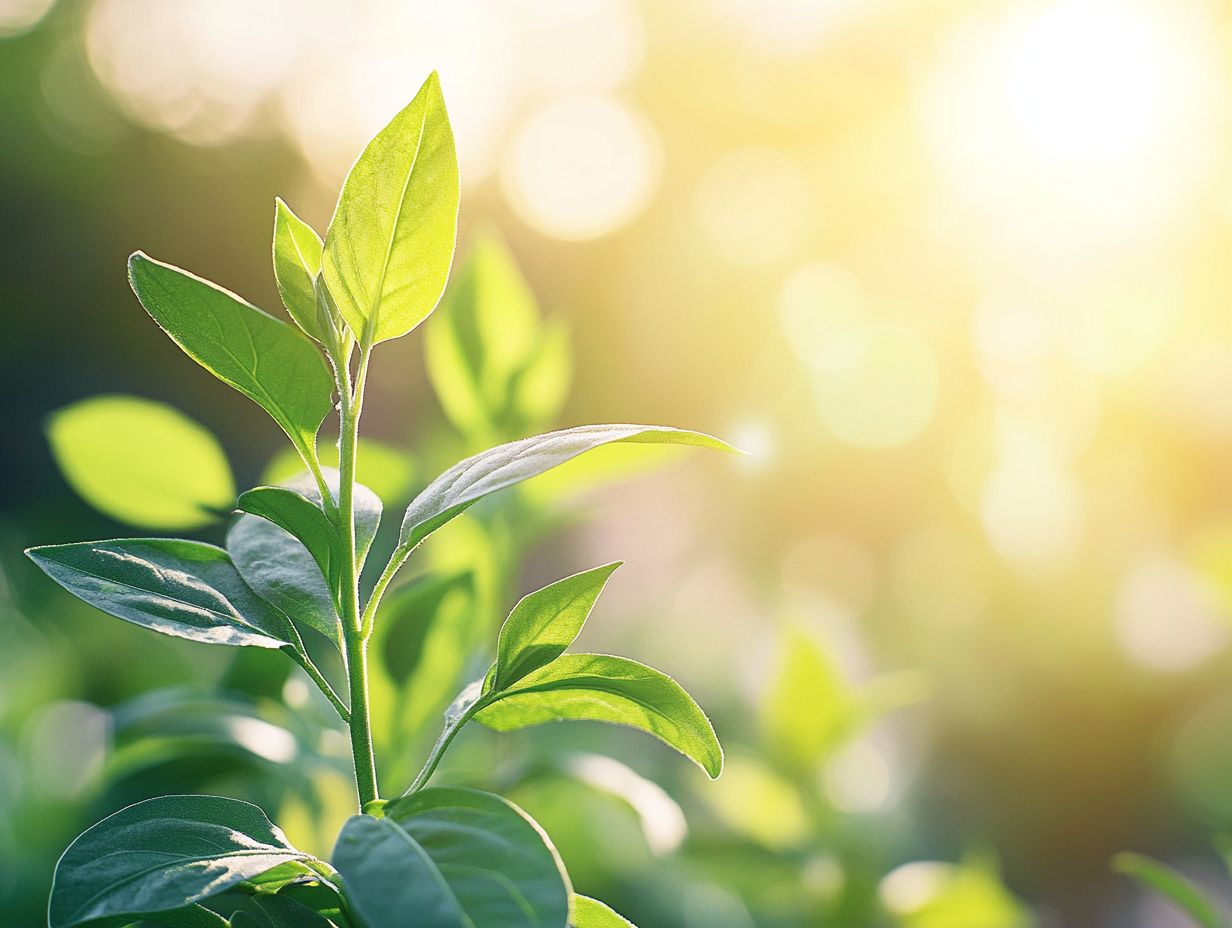
The type, intensity, and duration of light all impact plant growth. Different colors of light can affect photosynthesis and influence plant growth in various ways. For example, blue light promotes vegetative growth while red light promotes flowering.
Can plants get too much light?
Yes, just like humans, plants can get sunburned from too much exposure to sunlight. This is known as photoinhibition and can cause damage to cells and affect plant health.
Can artificial light be used for plant growth?
Yes, artificial light can supplement natural light for plant growth. LED lights are popular for indoor gardening as they provide the necessary spectrum of light for photosynthesis.
How does light affect plant color?
Light influences the production of pigments in plants, which give them their color. For example, plants grown in low light may have less chlorophyll, resulting in a lighter green color.
What happens to plants without enough light?
Without enough light, plants may show stunted growth, pale or yellow leaves, and reduced flowering or fruiting. Check your light conditions to keep them healthy and vibrant!

